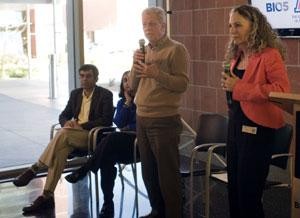Imbued with a record $50 million national grant, the UA is poised to become the global epicenter of plant science research over the next half decade and beyond.
The UA’s BIO5 Institute has become the official headquarters for the iPlant Collaborative, a multidisciplinary project that aims to unite scientists worldwide in solving plant-related challenges that affect the entire planet.
“”This is a national point of pride for the University of Arizona,”” said Vicky Chandler, director of BIO5. “”It’s actually going to be an international point of pride.””
The National Science Foundation bestowed the grant, the only one in the country and the largest financial award the UA has received from the organization.
The grant runs for five years, with the potential to be extended to ten.
“”I think everyone in Arizona has a lot to be proud of, and we’re very proud of this grant,”” said Arden Bement, president of the National Science Foundation.
The iPlant Collaborative will consist of a center on the fourth floor of BIO5, 1657 E. Helen St., in addition to an online “”cyberinfrastructure”” through which scientists worldwide can access and analyze data, Chandler said.
Their collective mission will be to diagram plants deemed important to life down to the smallest detail, so that ultimately solutions can be found to such comprehensive quandaries as global warming and hunger, she said.
“”We eat them. We wear them. Every breath we take depends on them. Plants are primary,”” Chandler said.
A prime motivation behind the project is that, by and large, scientists have yet to map plants, and how they interact with their environments to the extent that accurate models and other useful means of analysis can be developed to address global issues, she said.
Toward that end, the project will enlist a bevy of UA colleges, as well as a number of national research institutions, to identify “”grand-challenge questions,”” like how to feed a growing world population without stripping the earth of too many natural resources, Chandler said.
In all, the fields of computer science, plant science, math, biology, agriculture and management information systems, will come together to break down these impasses into manageable bits, she said.
Scientists will use emerging data sets to tackle those “”bite-size chunks”” individually, then use their conclusions to patch together wide-scale solutions, said Sudha Ram, a management information systems professor and part of the project’s leadership team.
A social networking component along the lines of Facebook will facilitate discussion, Chandler said.
Through that tool, about three grand-
challenge questions a year will be chosen among scientists, she said. The UA will then be foremost in the drive to create the technology and other tools necessary to address them.
Students and teachers in grades K-12 will eventually gain access to the data, marking “”the first time in the history of science”” that the general public and scientists will be viewing the same information simultaneously, Chandler said.
“”It’s the most exciting and complex research project I’ve ever participated in,”” she said. Nearly 80 percent of the grant money will go to the UA. The Cold Spring Harbor Laboratory (N.Y.) will receive 16 percent and Arizona State University will receive 4 percent.
The money will go out in increments of $10 million each year.









